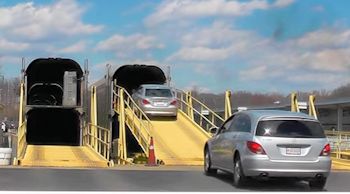Last week my husband and I made our move. After decades of living in Upstate NY, we moved to Florida (hey! It’s hot down here!) – and are now transitioning to new lives in a new place, with new friends, new challenges, new fun and more.
The 1200+ mile trip itself was made a little easier by taking the Amtrak Auto Train. If you aren’t familiar with the Auto Train, it’s a service that transports both you and your car, leaving from the Washington DC area and traveling non-stop to Sanford, Florida, just north of Orlando. Your car is loaded onto a special train car built for that purpose, while you ride in a nicely equipped passenger train car.
It’s a long trip – 800+ miles – and by train it is scheduled for 17 hours, leaving late in the afternoon and arriving early the next morning. Because the trip takes so long, they include additional services as part of the price including two meals (dinner, and breakfast the next morning), movies, a lounge car, internet access and other amenities to help you while-away those many hours. You even sleep right on the train, either in a sleeping car or right at your seat.
So why do I wax poetic about the Auto Train on a blog that is focused on private, independent patient advocates?
Because, oddly enough, I think we private, independent advocates can take some lessons from the Auto Train service – both positives and negatives.
Lesson #1: Find a Need and Fill It
The Auto Train has been available for north-south travel for decades. I can just hear the train of thought (pun intended!) that was used to create the service – the aha! moments that led to its development. Amtrak, which already had trains going north and south, realized that there were potentially millions of people who wanted to fast track (more pun intended!) to the south in the winter, and the north for the warmer months. They could fly, of course, but what if they wanted their own cars for the many months they would stay north or south, or simply didn’t want the added expense of a rental car? They could drive, of course, but the trip can take several days, plus the costs of hotels, meals, gas, plus wear-and-tear on a car…. but a train trip could get passengers there overnight and save the cost of those hotels, meals, gas and time…. Adding a few train cars that could stack automobiles added very little additional cost to Amtrak – just the cost of loading the cars, unloading the cars, and probably some additional energy cost for hauling the added weight. It was a brilliant and successful business expansion idea.
Patient advocates can do the same. Most advocates go into business thinking “These are the services I would like to provide and which I have skills to provide.” But that approach should be only the starting point. As time goes on, we need to observe and listen to what people ask for, then develop added services, or shift what we offer, to provide the sweet spot our clients are looking for, then figure out a way that makes sense for us to provide those new services.
Example: a med-nav advocate realizes that most of her clients also need help with medical billing problems, or getting insurance claims approved. She realizes that rather than just referring her clients to someone who specializes in those services, she could instead work with one of those specialists to subcontract those services and increase her own income with that relationship.
 Lesson #2: Be Flexible
Lesson #2: Be Flexible
This is at least one problem Amtrak hasn’t been able improve; a headache and inconvenience since trains were invented. That is – there is only one track. So if there is a problem on the track, the train just has to stop and wait. (Yes, sometimes there is a parallel track available, but those are rare.)
As advocates, we develop our processes, but we have to be willing to vary the route when a roadblock gets in the way. In fact, the very lack of alternative routes is one of the major problems the healthcare system has, and the fact that patients have been kept in the dark about how to be smart patients means they rarely have the ability to think of alternative routes themselves. That is often why they hire us to begin with.
Finding success through flexibility is one of the great benefits patients find by hiring a patient advocate, making it very important that you, the advocate, hone that ability. Doctors, nurses, and anyone who works inside the reimbursement system are constantly challenged with what can, and cannot, be done for a patient. As privately-paid advocates, we can get around those constraints. That makes flexibility part of our value proposition; one of the most important aspects of our work.
Embrace flexibility – and get good at it!
Lesson #3: Under Promise and Over Deliver
I’ve ridden the Auto Train on three different occasions since early February. During all three trips, the train was forced to a dead stop for periods of time throughout the rides (a car or an animal on the track? snow or ice?), adding as much as 45 minutes to an hour to the trip. But we never arrived late to our destination because Amtrak did a good job of managing expectations. Before you leave the station, you know that the train will arrive at approximately 9 AM the next morning. On two of my trips, we arrived within 2-3 minutes of that 9 AM time, and on one trip we arrived 30 minutes early!
How did they do that? The trip by itself, with no stops, probably takes 16 hours. But they know there will be stops, and therefore, they build extra time into the schedule. Now, if we had arrived an hour late, I might have been upset. But no one is ever upset about arriving early! So the smart schedulers just added that hour to the schedule, so that I would either be satisfied, or happy – or both!
You can take the same sort of approach with your advocacy practice. You can estimate a client’s project to take 12 hours, and quote 12 hours worth of work, but only bill them for 11-1/2 hours – and they will feel as if they got a bargain. You can arrange to meet a client at her doctor’s office while she rides in the medical service van while you drive your car – but not charge her the $20 the van service charges – and she’ll feel like you’ve provided a bonus. These are examples of ways you provide your client with more than she expected, making her happy, providing her with substance for word-of-mouth marketing on your behalf, and encouraging her to hire you to help her even further.
Of course, there were many other lessons that could be learned from the Auto Train; this is just a start.
Now I have two challenges for you:
- Begin to observe other service businesses unrelated to advocacy and see what lessons you can derive from them – both positives and negatives. What do you wish they did differently? What do you appreciate about their service? How can you translate your impressions of working with them to improving your service to your clients?
- Share those ideas and the lessons you’ve learned with the rest of us, in the comments section below.

Soon you’ll begin thinking differently about your interface with other businesses, large and small. You’ll begin to think like the customer or client, and as long as you can then translate that thought process to improvements in your approach to your business, your practice will continue to succeed, and to thrive.
LEARN ABOUT APHA MEMBERSHIP | FIND MORE REASONS PATIENTS NEED ADVOCATES






Great analogy. Everything you must do to price your services correctly.